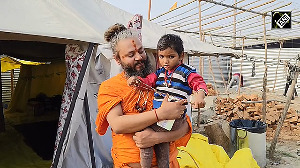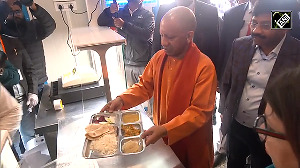The Gulf War in 1990-91 changed the way India watched television. Cable TV gave us the ringside view from the safety of our homes. Over the next 15 years, it gained access to 68 million households. But, today it faces its first real threat -- from direct-to-home (DTH) TV. But does it make sense for you to switch to the new technology and close the door on the cable guy?
To answer that question, let's look at the three available choices. All the three technologies involve signals that are beamed up to satellites, which send them back, all spread out. The difference is in how you receive the signal.
The cable guy: Are you happy?
Cable operators receive radio frequency signals using dish antennae. They have to pay the broadcaster to decode the signals, which are then transmitted to homes through cables. Most local operators offer poor signals and indifferent service. Charges vary from Rs 150 to Rs 350 a month for 60-100 channels of their choice, not yours.
So, you end up paying for stuff you don't watch, and miss out on what you want to view. Besides, every time there is a dispute between the cable operators and a broadcaster, mostly about prices or revenues, the former promptly switches off the latter's bouquet (set of channels, usually sold as a package), leaving you high and dry.
CAS: Certainly no success
In 2003, the government tried to implement the conditional access system (CAS) in the four metros, but without success. As of now, only Chennai has CAS. But that could change soon as, following a Delhi High Court order, the government notified on 31 July that CAS would have to be implemented in specific areas of Delhi, Kolkata and Mumbai from 1 January, 2007.
This technology is similar to that of cable TV, except the signal is decoded by you rather than the operator. A set-top box (STB) attached to your TV does the job only for subscribed channels. Theoretically, it is better than cable TV as you choose what you want to watch and pay only for that. But practically, it may not work that way.
Look at Chennai: Without the STB, a viewer there could watch only the 'free-to-air' channels for Rs 100 a month. To watch a pay channel, he had to buy an STB, which costs Rs 3,000 now, for each TV set. Depending on what he watched, subscription was Rs 100-400 a month. And for Rs 400, he could watch all the channels that the rest of India watched without STBs.
Also, as most broadcasters sell bouquets, he still paid for channels that he didn't watch. Relocation, even within Chennai, often meant getting new STBs, as each works only on a specific network. Aparna Parekh, who spent the last year in Chennai as a student, says: "I did not have an STB and could watch only Zee Music or NDTV. No HBO, no MTV, there was nothing."
Globally, CAS has caught on as broadcasters seeded the market with STBs, lowering the entry barrier. Now, things are moving that way in India too. Siti Cable, for instance, is letting viewers hire STBs by paying a deposit and monthly rents.
DTH: Removing the middlemen
If you think CAS is too much to handle, you have another choice. In fact, DTH could render CAS and its associated problems redundant. In DTH, the signals are beamed down by a satellite and received by a dish antenna in your home that is connected to an STB. No cable operator here either. Thereafter, it works like CAS.
Tata Sky CEO and managing director Vikram Kaushik says: "It (the signal) can reach every part of the country. Also, once a customer purchases DTH hardware, he can use the same unit anywhere."
As of now there are three players in the market -- Doordarshan's DD Direct, Essel Group's Dish TV and the Tata-Star TV joint venture Tata Sky.
DD Direct (www.ddinews.gov.in/DTH) offers you an inexpensive option. Once you pay a maximum of Rs 3,000 for the equipment, you can receive 19 DD channels, 14 broadcasters' channels and 12 audio channels of All India Radio. You don't have to pay anything more.
The big fight, however, is between Dish TV (www.dishtvindia.in) and Tata Sky (www.tatasky.com). They are not just shooting for city slickers willing to pay a bit more for a better viewing experience, but also trying to rope in rural audiences that do not have access to cable connections.
What do they have to offer? DVD quality picture, CD quality (Tata Sky) or stereophonic (Dish TV) sound, and standard value-added services like games, child locks, and the electronic programme guide. Besides, you can watch your favourite movies on demand and without ad breaks. But take the 'watch the latest blockbuster' claim with a pinch of salt. Dish TV gives you a choice of two Hindi and two English movies every week, while Tata Sky offers two Hindi movies in two weeks, for Rs 50 per movie.
However, you can only choose a movie that has premiered on TV already. So, you still need your local video library.
On the brighter side, with Dish TV you can pause live TV for later viewing and record up to 100 hours of programming (six channels simultaneously). The ace in the pack, however, is interactive TV. You not only decide what to watch, but how to watch it. Channel surfing could end as both Tata Sky and Dish TV let you watch four news channels or different parts of a news programme simultaneously on split screens.
And if you are watching cricket, you can pick your own camera angles for every shot, listen to commentary in different languages, and watch player statistics, match scorecards and highlights whenever you want. And all this on your old TV set.
Installation would cost around Rs 4,000 and subscription Rs 160-200 a month. Anjali Malhotra, vice-president (marketing), Dish TV, says, "We want to keep in mind the technological advancements and give the viewers value for money."
The million-dollar question
So what do you plump for? First, you have to decide what do you want to watch. If a DTH provider does not give you the channels you watched earlier, but gives other channels, does that swap suit you? Because of Trai's 'must provide' clause, you can watch some Zee channels on Tata Sky and some Star Channels on Dish TV.
A DTH broadcaster will beam the same bouquet to all parts of India. So, there might be fewer regional channels than what a local cable operator can provide. Besides, the latter scores with new film releases, although shown illegally.
Sudeep Sengupta, a business consultant, says, "I wasn't happy at all with my cable operator. So, I subscribed to Tata Sky as it is a good long-term investment." If you are looking for specific extras, check how much more you have to pay for them. Again, with new features, see what works for the equipment you have. For instance, if you have a small-screen TV, is the split-screen option any good?
However, if you belong to an area where CAS is going to made compulsory, you have to choose between buying an STB from your cable guy, or subscribing to DTH, if you want to go on watching the pay channels. A quick price comparison for what you want to watch should settle it (see: Figuring Out the Costs).
|
Figuring Out the Costs | |||
|
service |
Initial Investment (Rs) |
Monthly subscription (Rs) |
number of Channels |
|
Cable TV |
500-1,000 (installation charge) |
150-350 (depending on where you stay) |
60-100 (all popular channels) |
|
CAS1 |
3,000 (hardware+installation) |
100-400 (100 to view 'free to air' channels only; 400 to watch all channels) |
Depends on the bouquet of channels you subscribe to (Rs 400 for all bouquets) |
|
Tata Sky |
2,999 (hardware)+1,000 (installation+ 1-year warranty) |
200/month |
110 (based on TRP). A good mix, but all regional channels might not be available |
|
Dish TV |
Welcome offer: 2,950 (hardware)+200 (installation)+440 (prepaid card+3 months subscription) |
160/month (plus taxes) in South India, 180/month (plus taxes) for the rest of India |
80 channels (a good mix, but all regional channels not available)+Dish TV exclusives |
|
|
Maxi Offer: 3,000 (hardware)+200 (installation)+690 (prepaid card+ 3 months subscription) |
300/month (plus taxes) |
125 channels+(more to choose from)+ some Dish TV exclusives |
|
DD Direct |
Around 3,000 (hardware) |
Nil |
19 DD channels+14 pvt TV channels +12 AIR channels |
|
1From 1 Jan 2007 STB can be rented for Rs 250-999 as deposit and Rs 30-45 as monthly rental; 'free to air' channels will cost Rs 77 and each pay channel will cost Rs 5 maximum | |||
And what if you have more than one TV set at home? You have to take subscriptions and buy hardware for each set. Both Tata Sky and Dish TV offer some benefits, but the prices are not too different.
Given the complexity, your idiot box could demand a few smart decisions when you try to choose the best option.






 © 2025
© 2025